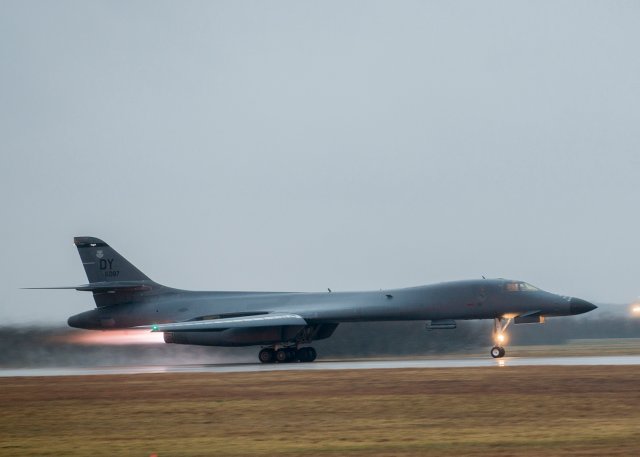Breaking news
USAF's Block 16 B-1 bomber performs first-ever long-range strike drill.
| a | |||
|
|
|||
|
World Aviation Defense & Security News - United States
|
|||
|
|
|||
|
USAF's Block 16 B-1 bomber performs first-ever long-range strike drill
|
|||
|
After more than a decade of performing precision strike operations in the U.S. Central Command Area of Responsibility, the B-1 Lancers have returned home. While U.S. and coalition aircraft step in to continue the air campaign in Iraq and Syria, where B-1s from Dyess and Ellsworth Air Force Bases delivered devastating blows to Daesh forces, the Lancers are stateside, completing the largest fleet sustainment block upgrade in the program's history.
|
|||
|
|
|||
 A 9th Bomb Squadron B-1B Lancer at Dyess Air Force Base, Texas, begins its 15-hour flight to the Alaskan Yukon Range Feb. 23, 2016, during a B-1 Combat Mission Effectiveness Exercise A 9th Bomb Squadron B-1B Lancer at Dyess Air Force Base, Texas, begins its 15-hour flight to the Alaskan Yukon Range Feb. 23, 2016, during a B-1 Combat Mission Effectiveness Exercise(Credit: USAF/Airman 1st Class Austin Mayfield) |
|||
|
|
|||
|
The 7th Bomb Wing is wasting no time putting those upgrades to work, recently executing a short-notice, long-range strike exercise to successfully demonstrate, for the first time, the Air Force's ability to deploy Block 16 B-1s during a 15-hour flight to the Yukon Range in Alaska. "This exercise proved that the B-1 fleet is now capable of deploying and employing Block 16 aircraft to provide a global strike presence within hours of being tasked," according to Capt. Ryan Stillwell, wing weapons officer, adding that the Block 16 modifications allow the aircraft to perform more efficiently and effectively than ever before. A key element of the modifications he pointed out is that the upgrade allows better data sharing between aircrew and aircraft in the sky. "The Block 16 upgrade results in increased situational awareness in the jets as well as increased reliability in our systems and displays," Stillwell said. "This ties us into the external sensors the rest of the Air Force and military provide in a more usable way." This enhanced capability not only aids the crew of the B-1, but allows other military assets to be better prepared against enemy threats. "B-1s are a global deterrence platform in the conventional strike role; we can put bombs on targets anywhere in the world, anytime," Stillwell said. "Block 16 enables that because it increases our situational awareness and it makes us more lethal. We can share target and threat data with other assets, which help us survive and allow us to place our weapons in an accurate location in a quicker timeline against the enemy." Block 16 has made the B-1 a complete combat machine, the captain added. "The B-1 is not limited to a certain sortie duration," Stillwell said. "Our B-1s are only limited to crew fatigue, as long as the crew is rested and we get in-air refueling there is no limit to how far our B-1 can go." An important piece of the exercise was to ensure the Block 16 B-1s are ready for that long-duration mission. "One of the key planning factors was demonstrating the global reach of the B-1," said Lt. Col. Luke Baker, 7th Bomb Wing director of inspections. "We also wanted to demonstrate its global capability with long-range and precision attacks, which allows us to reach out and touch people across the world." During this exercise the B-1's three weapons bays were loaded with inert Joint Air-to-Surface Standoff Missiles and Joint Direct Attack Munitions. Both sets of weapons benefit the addition of the Block 16 technology by allowing the weapon systems officers to be more accurate in targeting the enemy. While exercising a new system successfully was one objective, Stillwell pointed out that this exercise was also critical in ensuring the wing is capable of getting jets and Airmen ready to deploy in a short-notice scenario. "We did this exercise to exercise the machine that is Dyess Air Force Base, which eventually results in putting bombs on targets," Stillwell said. "We were able to get all six aircraft launched on time. From the maintenance side and operation side they had everything ready before we launched the aircraft." A successful deployment or exercise ultimately hinges on the skill and dedication of Airmen, and according to the 7th Bomb Wing vice commander, he never doubted they would achieve the targeted goal. "It doesn't surprise me that our Airmen were able to accomplish such a large task on such short order, because we have developed a 'bomber Airmen' culture, who are ready to defend the nation at any time," Col. Michael Miller said. "These upgrades just further enhance the ability of our Airmen to do what they do best, which is putting steel on target." |
|||
,


























